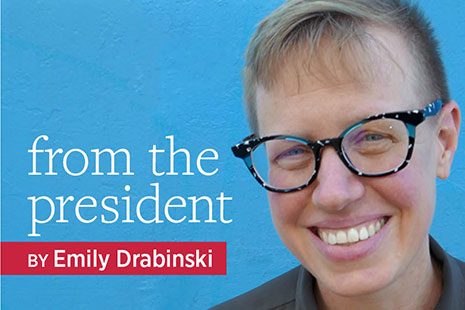
“What does ALA actually do?”
As president of ALA during this critical moment in history, I get asked this question a lot. Libraries and library workers are both in the spotlight and under the microscope, and people want to know who we are and what we do. Maybe you’ve even asked this question yourself. One of the joys of this role is that I get to learn and share about what all of us do.
During a visit to Chicago last fall, I had breakfast with Benjamin Aldred, chair of ALA’s Government Documents Round Table (GODORT). Aldred discussed concerns he and his members grapple with each day, including maintaining access to and preservation of government information in an all-digital world. I also know from talking with public library workers across the country that connecting patrons to public services is a huge part of the job. Public Library Association members work together to develop model practices while GODORT members address the knotty structural problems that can come with digital government.
There are so many examples of this kind of work across ALA:
- Our Games and Gaming Round Table generates selection criteria for collection development.
- The Federated Authentication Committee from our Core division addresses user experience and privacy concerns in the single sign-on landscape.
- The Reference and User Services Association’s History Section annually develops a list of the best resources for historical research, which is invaluable for librarians working with these materials and the communities they serve.
- In partnership with the Chief Officers of State Library Agencies, members of our Young Adult Library Services Association division implemented Transforming Teen Services: A Train-the-Trainer Approach. This brought state library agency youth consultants and frontline library staff together to innovate and expand services to young people in five states.
Much of what we do can be difficult for people outside of our field to understand. How many times have I heard people describe interlibrary loan, a service that depends on the labor of thousands of library workers, as magic? My partner, a historian, regularly “discovers” documents in archival collections acquired, arranged, described, preserved, and made accessible by our colleagues in the Association of College and Research Libraries’ Rare Books and Manuscripts Section.
As we’ve seen troubling calls for membership withdrawals from some states, the need for a clear and public articulation of the importance of ALA to library professionals and the communities we serve is as important as it has ever been.
What I value most is the role ALA has played since its founding in 1876: convening library workers together in service of our shared mission “to provide leadership for the development, promotion, and improvement of library and information services and the profession of librarianship in order to enhance learning and ensure access to information for all.”
In 2022, ALA Council charged a task force with reviewing the Association’s core values to ensure they reflect our commitments in a changing world. This difficult and important member-led work generated five values—access, equity, intellectual freedom, public good, and sustainability—to be debated, discussed, and potentially adopted by our elected Council at our 2024 LibLearnX conference in Baltimore this January.
Our mission and values are my North Star as all of us navigate these challenging waters.

